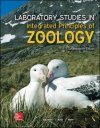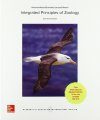About this book
This practical spiralboud guide is to be used alongside the textbook Integrated Principles of Zoology. Uses a comprehensive, phylogenetic approach in emphasizing basic biological principles, animal form and function, and evolutionary concepts.
Contents
PART ONE. Introduction to the Living Animal
Exercise 1
The Microscope 3
Exercise 1A: Compound Light Microscope 3
Exercise 1B: Stereoscopic Dissecting Microscope 8
Exercise 1C: Electron Microscope 9
Exercise 2
Cell Structure and Division 13
Exercise 2A: The Cell — Unit of Protoplasmic Organization 13
Exercise 2B: Cell Division — Mitosis an dCytokinesis 16
Exercise 3
Gametogenesis and Embryology 25
Exercise 3A: Meiosis — Maturation Division of Germ Cells 25
Exercise 3B: Cleavage Patterns — Spiral and Radial Cleavage 36
Exercise 3C: Frog Development 44
Exercise 4
Tissue Structure and Function 47
Exercise 4: Tissues Combined into Organs 54
Part Two. The Diversity of Animal Life
Exercise 5
Ecological Relationships of Animals 63
Exercise 5A: A Study of Population Growth, with Application of the Scientific Method 63
Exercise 5B: Ecology of a Freshwater Habitat 67
Exercise 6
Introduction to Animal Taxonomy 77
Exercise 6A: Phylogeny Reconstruction — How to Make a Cladogram 78
Exercise 6B: Use of a Taxonomic Key for Organism Identification 83
Exercise 7
Unicellular Eukaryotes 89
Exercise 7A: Phylum Amoebozoa — Amoeba and Others 89
Exercise 7B: Phyla Euglenozoa and Viridiplantae — Euglena, Volvox, and Trypanosoma 97
Exercise 7C: Phylum Apicomplexa — Plasmodium and Gregarina 106
Exercise 7D: Phylum Ciliophora — Paramecium and Other Ciliates 109
Experimenting in Zoology: Effect of Temperature on the Locomotor Activity of Stentor 115
Experimenting in Zoology: Genetic Polymorphism in Tetrahymena 117
Exercise 8
The Sponges 121
Exercise 8: Class Calcispongiae — Sycon 121
Exercise 9
The Radiate Animals 131
Exercise 9A: Class Hydrozoa — Hydra, Obelia, and Gonionemus 132
Exercise 9B: Class Scyphozoa — Aurelia, a “True” Jellyfish 138
Exercise 9C: Class Anthozoa — Metridium, a Sea Anemone, and Astrangia, a Stony Coral 140
Experimenting in Zoology: Predator Functional Response: Feeding Rate in Hydra 147
Exercise 10
The Flatworms 149
Exercise 10A: Class Turbellaria — Planarians 150
Exercise 10B: Class Trematoda — Digenetic Flukes 153
Exercise 10C: Class Cestoda — Tapeworms 158
Experimenting in Zoology: Planaria Regeneration Experiment 167
Exercise 11
Nematodes and Four Small Protostome Phyla 171
Exercise 11A: Phylum Nematoda — Ascaris and Others 172
Exercise 11B: A Brief Look at Some Other Protostomes 179
Exercise 12
The Molluscs 183
Exercise 12A: Class Bivalvia = Pelecypoda) — Freshwater Clam 184
Exercise 12B: Class Gastropoda — Pulmonate Land Snail 191
Exercise 12C: Class Polyplacophora — Chitons 194
Exercise 12D: Class Cephalopoda — Loligo, the Squid 195
Exercise 13
The Annelids 201
Exercise 13A: Class Errantia — Clamworm 202
Exercise 13B: Class Sedentaria Earthworm 204
Exercise 13C: Family Hirudinidae — Leech 215
Experimenting in Zoology: Behavior of Medicinal Leeches, Hirudo medicinalis 217
Exercise 14
The Chelicerate Arthropods 219
Exercise 14: Chelicerate Arthropods — Horseshoe Crab and Garden Spider 220
Exercise 15
The Crustacean Arthropods 227
Exercise 15A: Subphylum Crustacea — Crayfish, Lobsters, and Other Crustaceans 227
Experimenting in Zoology: The Phototactic Behavior of Daphnia 239
Exercise 16
The Arthropods 241
Exercise 16A: Myriapods — Centipedes and Millipedes 241
Exercise 16B: Insects — Grasshopper and Honeybee 243
Exercise 16C: Insects — House Cricket 251
Exercise 16D: Metamorphosis of Drosophila 254
Exercise 16E: Collectionand Classification of Insects 255
Exercise 17
The Echinoderms 265
Exercise 17A: Class Asteroidea — Sea Stars 266
Exercise 17B: Class Ophiuroidea — Brittle Stars 270
Exercise 17C: Class Echinoidea — Sea Urchins 273
Exercise 17D: Class Holothuroidea — Sea Cucumbers 275
Exercise 17E: Class Crinoidea — Feather Stars and Sea Lilies 278
Exercise 18
Phylum Chordata: A Deuterostome Group 281
Exercise 18A: Subphylum Urochordata — Ciona, an Ascidian 283
Exercise 18B: Subphylum Cephalochordata — Amphioxus 285
Exercise 19
The Fishes — Lampreys, Sharks, and Bony Fishes 291
Exercise 19A: Class Petromyzontida — Lampreys (Ammocoete Larva and Adult) 291
Exercise 19B: Class Chondrichthyes — Cartilaginous Fishes 296
Exercise 19C: Class Actinopterygii — Bony Fishes 301
Experimenting in Zoology: Agonistic Behavior in Paradise Fish, Macropodus opercularis 307
Experimenting in Zoology: Analysis of the Multiple Hemoglobin System in Carassius auratus, Common Goldfish 309
Exercise 20
The Amphibians: Frogs 313
Exercise 20A: Behavior and Adaptations 314
Exercise 20B: Skeleton 318
Customer Reviews
Biography
Cleve Hickman is Professor Emeritus at Washington and Lee University, Lexington, VA. He received his Ph.D. in Zoology from the University of British Columbia, did research in animal physiology for eight years, and taught zoology for over 30 years. He's made over 20 trips to the Galapagos Islands for research and as an instructor for student field trips.
Larry Roberts is currently teaching parasitology and marine biology at the University of Miami. He received his Ph.D. in Parasitology from Johns Hopkins University and is a coauthor of Foundations of Parasitology, 5/e. Past teaching affiliations include University of Massachusetts, Texas Tech University, and Florida International University. Dr. Roberts has authored numerous research articles and a title of related interest: Underwater World of Sport Diving.
Allan Larson is an Associate Professor at Washington University, St. Louis, MO. He received his Ph.D. in Genetics at the University of California, Berkeley. His fields of specialization include Evolutionary Biology, Molecular Population Genetics and Systematics, and Amphibian Systematics. He's taught courses in general biology, evolution, and population biology.
































